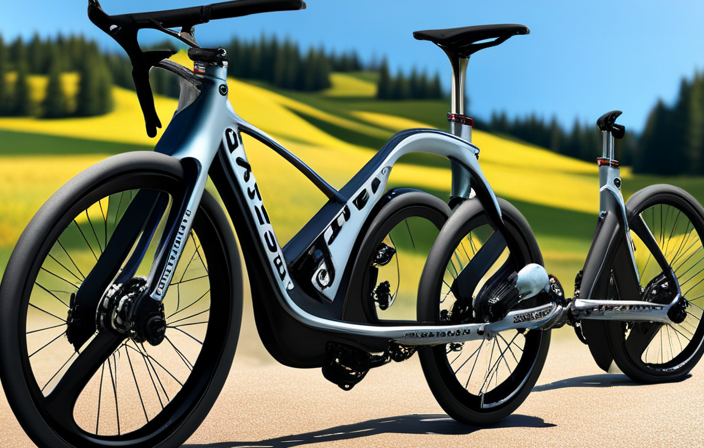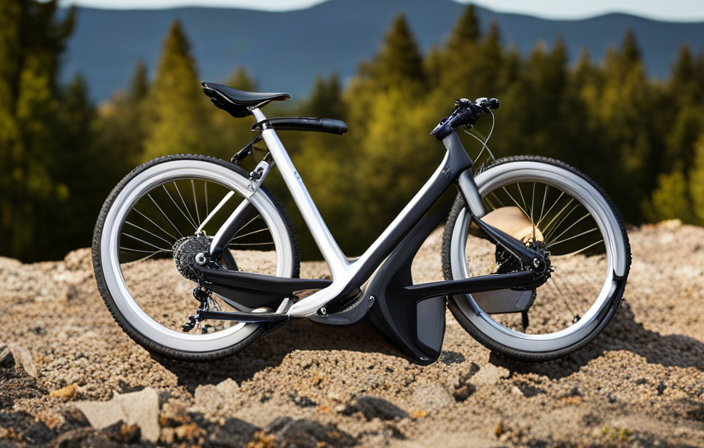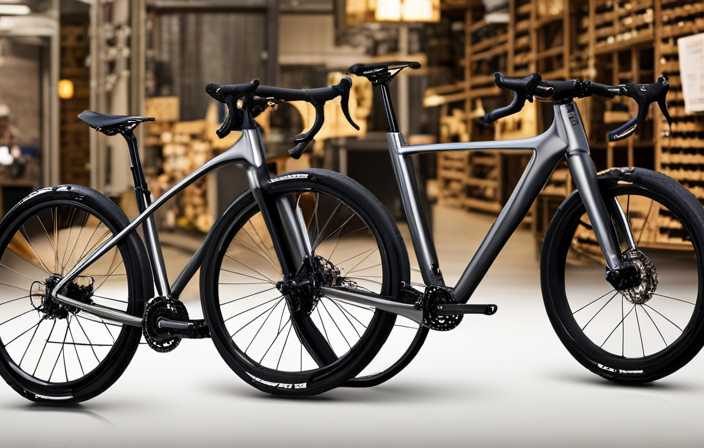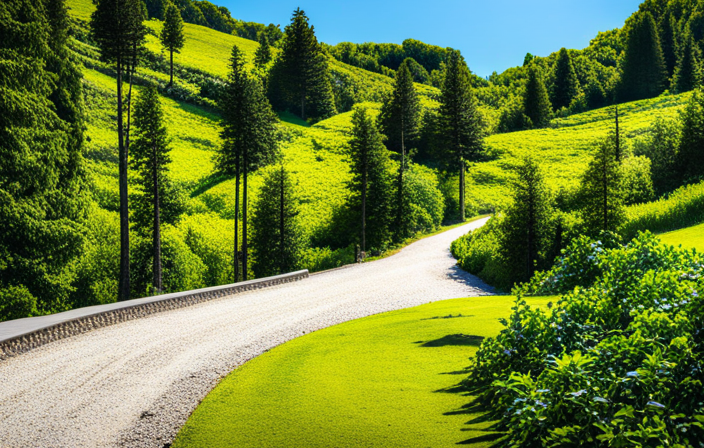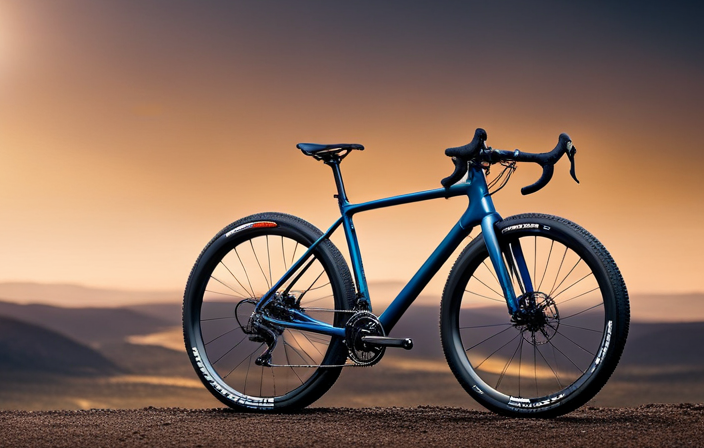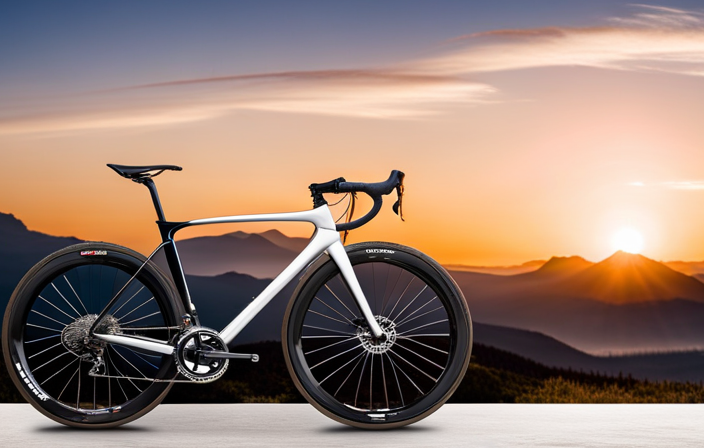When it comes to navigating rough terrain on your gravel bike, selecting the appropriate pedals can feel like searching for a needle in a haystack. With numerous choices on the market, it can be daunting to find the ideal match.
But fear not, fellow adventurers! In this article, I’ll guide you through the world of pedal possibilities, from clipless and platform pedals to hybrid and SPD variations.
We’ll also delve into maintenance tips, accessories, and expert recommendations for optimal performance on your gravel escapades.
So let’s dive in and find those dream pedals that will keep you pedaling with confidence and control!
Key Takeaways
- Choose pedals based on your riding preferences and needs, considering factors such as power transfer, control, engagement/disengagement speed, and compatibility with footwear.
- Consider the pros and cons of different pedal types, including clipless pedals for secure connection and efficient power transfer, platform pedals for versatility and easier foot stability, hybrid pedals for a combination of clipless and platform features, and SPD pedals for off-road performance.
- Regular maintenance and care, such as cleaning, lubrication, and checking for wear and tear, are essential to ensure the longevity and performance of your pedals.
- Pedal accessories, such as toe cages and pedal straps, can enhance security and foot retention, but their use should be based on personal preference and riding style.
Clipless Pedals
Clipless pedals are a popular choice for gravel bike riders. They offer several benefits that make them appealing for off-road adventures. One of the main advantages of clipless pedals is the increased efficiency they provide. By securely connecting your shoes to the pedals, you can transfer power more effectively with each pedal stroke, resulting in improved speed and control on rough terrains.
When choosing clipless pedals for your gravel bike, it’s important to consider the type of shoe you will be using. There are different cleat systems available, such as SPD-SL or SPD, which require specific shoes compatible with those systems. It’s crucial to choose the right shoe that fits well and offers enough stiffness for efficient power transfer while still being comfortable for long rides.
Additionally, clipless pedals allow for easy engagement and disengagement. This feature is particularly useful when navigating technical sections or encountering obstacles on gravel trails. Being able to quickly release your feet from the pedals provides a sense of security and enhances maneuverability.
Transitioning into the subsequent section about platform pedals, it’s worth noting that while clipless pedals offer many advantages, some riders prefer platform pedals due to their simplicity and ease of use in certain situations.
Platform Pedals
Try out platform pedals for a comfortable and versatile option when riding off-road.
Platform pedals are a great choice for gravel biking because they offer a larger surface area to support your feet, providing better stability and control on rough terrain.
One of the main considerations when choosing platform pedals is the balance between weight and durability. Lightweight pedals are ideal for minimizing extra weight on your bike, but they may not be as durable as heavier options. It’s important to find a pedal that strikes the right balance for your specific needs.
Another factor to consider with platform pedals is shoe compatibility versus personal preference. Some platforms have pins or spikes that provide added grip, which can be beneficial in muddy or slippery conditions. However, these pins may also cause damage to certain types of shoes or make it difficult to reposition your foot quickly while riding. Ultimately, it comes down to personal preference and finding a pedal that suits both your shoes and riding style.
As we transition into the next section about hybrid pedals, keep in mind the advantages and disadvantages of platform pedals discussed here.
Hybrid Pedals
When riding off-road, one option to consider is using hybrid pedals. These pedals combine the benefits of platform pedals and clipless pedals, giving you the best of both worlds. Here are three key benefits of using hybrid pedals:
-
Easy Transition: Hybrid pedals have a flat side that allows you to ride with regular shoes. This makes them perfect for commuting or short rides where you don’t want to wear cycling-specific footwear. When you need more power and efficiency, simply flip the pedal over to engage the cleat system.
-
Secure Connection: The clipless side of hybrid pedals ensures a secure connection between your shoe and the pedal. This prevents any slippage during aggressive off-road riding, giving you better control and confidence on challenging terrain.
-
Customizable Tension: Most hybrid pedals allow you to adjust the tension of the cleat release mechanism. This means you can tailor the pedals to your preference, whether you prefer an easy release for quick dismounts or a tighter hold for maximum power transfer.
Choosing the right hybrid pedal depends on factors such as weight, durability, and ease of maintenance. Now let’s delve into another popular pedal option – SPD pedals – which offer their own unique advantages in off-road cycling adventures without compromising convenience and versatility.
SPD Pedals
For an off-road adventure that prioritizes convenience and versatility, SPD pedals offer their own unique advantages. These clipless pedals provide a secure connection between your shoes and the bike, ensuring efficient power transfer and control over rough terrain. The ability to quickly engage and disengage from the pedal is essential for navigating technical sections or unexpected obstacles.
When it comes to choosing the right cleats for your SPD pedals, there are different options available depending on your riding style and preferences. The most common type of cleat is the two-bolt design, which offers a good balance between walkability and stability on the bike. This makes them ideal for gravel riding where you may encounter both off-road trails and pavement.
To help you understand the differences between clipless pedals and platform pedals, here’s a comparison table:
| Clipless Pedals | Platform Pedals |
|---|---|
| Secure connection | No need for special shoes |
| Efficient power transfer | Easy to use with any footwear |
| Better control over rough terrain | Increased foot stability |
| Quick engagement/disengagement | Easier to bail in emergencies |
With this information about SPD pedals in mind, let’s transition into discussing flat pedals in the next section
Flat Pedals
To get a different riding experience, consider using flat pedals. Flat pedals are a great option for gravel biking because they allow for more freedom of movement and provide a different type of connection between the rider and the bike. When using flat pedals, weight distribution becomes crucial as it affects how well you can control your bike on uneven terrain. By keeping your weight centered and balanced over the bike, you can improve stability and maneuverability.
Another important aspect to consider when using flat pedals is pedal grip. Unlike clipless SPD pedals, which lock your shoes into place, flat pedals rely solely on the grip between your shoes and the pedal surface. Therefore, it is essential to choose flat pedals with good traction or use sticky rubber-soled shoes to ensure proper grip during rides.
Transitioning now to toe clips and straps, these accessories provide an alternative way to secure your feet onto the pedals without using clipless systems. They offer some level of foot retention while still allowing for quick disengagement when needed.
Next up in our exploration of gravel bike pedal options: toe clips and straps!
Toe Clips and Straps
When it comes to pedal options for gravel biking, there are various choices available. In my previous discussion about flat pedals, I highlighted their advantages in terms of ease of use and versatility. However, another option that deserves attention is toe clips and straps.
Toe clips are cages attached to the front of the pedals, allowing you to slide your feet in and secure them with straps. One important consideration when using toe clips is ensuring proper sizing. It’s crucial to select the right size that fits your shoes snugly but still allows for easy entry and exit.
Using toe clips offers several benefits for gravel biking. Firstly, they provide a more efficient transfer of power from your legs to the bike by allowing you to pull up on the pedals during the upstroke motion. This can result in increased pedaling efficiency and better overall performance.
Moreover, toe clips offer an added level of security by preventing your feet from slipping off the pedals during bumpy or technical sections of the trail. This enhanced control contributes to improved stability and confidence while riding.
As we explore further into weight and durability considerations in our next section, it’s essential to evaluate how different pedal options impact these factors without compromising performance or safety.
Weight and Durability Considerations
Consider the weight and durability of your chosen pedal option to ensure it meets your needs for long-lasting performance. When selecting pedals for your gravel bike, it’s important to strike a balance between weight and performance. While lighter pedals can improve efficiency and make climbing easier, they may sacrifice durability in the long run.
To help you make an informed decision, let’s compare the weight and durability of some popular pedal options in the table below:
| Pedal Option | Weight (grams) | Durability |
|---|---|---|
| Clipless | 250 | High |
| Platform | 400 | Medium |
| Combination | 350 | High |
| Toe Clips | 500 | Low |
As you can see, clipless pedals offer the lightest weight while still providing high durability. However, if you prefer a more versatile pedal that allows for both clipped-in and flat shoe riding, combination pedals might be a better choice. They provide a good balance between weight reduction and long-term durability.
Considering these factors will ensure that your chosen pedal option aligns with your specific needs for weight vs. performance and long-term durability. Now let’s delve into how float and cleat adjustments can further enhance your riding experience without compromising safety or comfort.
Float and Cleat Adjustments
When it comes to float and cleat adjustments, there are a few key points to consider for optimal performance on your gravel bike.
First, understanding the float range is crucial for allowing natural foot movement while pedaling. This adjustability can help prevent knee pain and discomfort during long rides.
Second, finding the right cleat positioning is essential for maximizing power transfer and efficiency. Small adjustments in angle or fore-aft placement can make a significant difference in your overall performance.
Lastly, fine-tuning your setup for comfort and efficiency involves experimenting with various adjustments, such as tension settings or shimming, to find the perfect balance that suits your individual needs as a rider.
Float Range for Natural Foot Movement
The float range of pedals allows for a natural foot movement while cycling on gravel. Float adjustment is an important feature that enables riders to customize their pedal system according to their preferences and foot alignment. By adjusting the float, cyclists can find the optimal balance between stability and freedom of movement.
To better understand the concept of float range, consider the following table:
| Float Range | Description |
|---|---|
| 0 degrees | No lateral movement allowed |
| 4 degrees | Limited lateral movement for stability |
| 8 degrees | Moderate lateral movement for comfort |
| 12 degrees | Increased lateral movement for flexibility |
| Unlimited | Full unrestricted lateral movement |
Choosing the appropriate float range will depend on individual riding style and personal preference. It is crucial to find a balance that promotes efficient power transfer while allowing natural foot motion.
Now let’s delve into cleat positioning for optimal performance without compromising safety and comfort.
Cleat Positioning for Optimal Performance
To achieve optimal performance, it’s important to position the cleats correctly. Proper cleat positioning techniques are crucial for power transfer optimization on a gravel bike.
The position of the cleats determines how efficiently you can transfer power from your legs to the pedals, affecting your overall performance and comfort.
When it comes to cleat positioning, there are a few key factors to consider. First, the fore-aft position should be adjusted so that the ball of your foot is directly over the pedal spindle. This allows for efficient power transfer and minimizes strain on your knees.
Additionally, side-to-side adjustment should be made to ensure that your feet are aligned with your natural pedal stroke.
Fine-tuning for comfort and efficiency involves finding the right amount of float for your riding style and preferences. Float refers to the degree of movement allowed by the cleat within its range of adjustment. It helps accommodate natural foot movement during pedaling and reduces stress on joints.
By optimizing cleat positioning techniques and fine-tuning for comfort and efficiency, you can enhance your gravel biking experience while maximizing performance.
Fine-tuning for Comfort and Efficiency
Fine-tuning for comfort and efficiency involves finding the right amount of float for your riding style and preferences, which can enhance your overall experience on the gravel bike. Float refers to the degree of rotational movement allowed by your pedals. It is important to adjust your cleats to a position that allows for a comfortable range of motion while still providing efficient power transfer.
In addition to cleat positioning, optimizing handlebar position and tire pressure are crucial aspects of fine-tuning your gravel bike. Adjusting the handlebar height, reach, and angle can greatly impact your comfort and control on long rides. Experiment with different positions until you find what works best for you.
Similarly, optimizing tire pressure is essential for achieving the right balance between grip and rolling resistance. Lower pressures provide better traction on rough terrain but may result in higher rolling resistance on smoother surfaces. Conversely, higher pressures reduce rolling resistance but sacrifice grip.
Considering these factors will help you achieve optimal comfort and efficiency on your gravel bike. Moving forward into the next section about shoe compatibility, it is important to ensure that all components work together seamlessly to maximize performance.
Shoe Compatibility
When choosing pedals for a gravel bike, it’s important to consider their compatibility with your shoes. Shoe sizing plays a crucial role in ensuring a comfortable and efficient ride. Ill-fitting shoes can lead to discomfort and even pain during long rides. Additionally, different pedal systems may have varying degrees of compatibility with different shoe brands and models.
Here are four key factors to consider when evaluating shoe compatibility:
-
Cleat Compatibility: Ensure that the pedal system you choose is compatible with the cleats on your shoes. Different brands use different cleat designs, so make sure they align properly.
-
Adjustable Tension: Some pedals offer adjustable tension settings, allowing you to fine-tune the engagement and release mechanism according to your preference.
-
Float Options: Float refers to the amount of lateral movement allowed by the cleat before disengaging from the pedal. Consider whether you prefer more or less float depending on your riding style.
-
Shoe-Pedal Interface: Assess how well your shoe interfaces with the pedal platform. Look for features like grip patterns or textured surfaces that enhance stability and prevent slippage.
Considering these factors will help ensure that you find pedals that not only fit your shoes but also enhance comfort, efficiency, and overall performance on your gravel bike.
Moving forward into the next section about personal preference and riding style…
Personal Preference and Riding Style
Consider your personal preferences and riding style to determine the best pedal choice for you. When it comes to gravel biking, there are a few different options to choose from. Your personal preference plays a significant role in this decision-making process. Some riders prefer flat pedals as they offer more freedom of movement and allow for quick foot placement on unpredictable terrain. On the other hand, clipless pedals provide a secure connection between your shoes and the pedals, which can enhance pedaling efficiency and power transfer.
Your riding style also influences pedal choice. If you enjoy technical descents or need to frequently dismount during rides, flat pedals might be the better option for you. They allow for easy foot adjustments and provide a sense of security when navigating challenging sections. However, if you prioritize speed and efficiency on long climbs or smooth surfaces, clipless pedals may be more suitable. They enable you to maximize power output by allowing you to pull up on the pedals during each stroke.
In conclusion, selecting the right pedal type ultimately depends on your personal preferences and riding style. Consider these factors carefully before making your decision. Now let’s dive into considerations for different terrains without further ado!
Considerations for Different Terrain
If you enjoy riding on various terrains, it’s important to take into account the different factors that come into play when choosing the right pedal for your needs. Different pedal types offer varying levels of performance and functionality, so selecting the appropriate one can greatly enhance your riding experience.
When considering different terrains, it’s crucial to think about how each pedal type performs in those specific conditions. To help you understand this better, let’s take a look at a comparison table:
| Terrain Type | Clipless Pedals | Flat Pedals |
|---|---|---|
| Smooth Roads | Excellent | Good |
| Gravel | Good | Excellent |
| Technical | Excellent | Good |
| Mud | Fair | Fair |
As shown in the table, clipless pedals excel in technical terrain and smooth roads due to their secure connection with cycling shoes. On the other hand, flat pedals provide superior performance on gravel surfaces and are more forgiving in muddy conditions.
By carefully considering the different terrain types you ride on, you can choose a pedal that maximizes your performance and comfort. Additionally, understanding how each pedal type functions will allow you to make an informed decision based on your riding style and preferences.
Now that we have explored considerations for different terrain, let’s delve into maintenance and pedal care.
Maintenance and Pedal Care
Proper maintenance and care are essential for ensuring the longevity and performance of your pedals. By following a few simple steps, you can extend the lifespan of your pedals and keep them functioning at their best.
Here are three key factors to consider when it comes to pedal maintenance:
-
Cleaning: Regularly cleaning your pedals is crucial for removing dirt, debris, and any other substances that may accumulate over time. Use a mild detergent and water solution to gently scrub the pedal surface with a soft brush. Rinse thoroughly and dry completely before reinstalling.
-
Lubrication: Applying lubricant to your pedal bearings will help reduce friction and ensure smooth rotation. Use a specific pedal bearing grease or oil recommended by the manufacturer, applying it sparingly to avoid excess buildup.
-
Inspection: Regularly inspecting your pedals for any signs of wear or damage is important in maintaining their overall condition. Check for loose or damaged parts, worn-out bearings, or any cracks on the pedal body. If you notice any issues, address them promptly to prevent further damage.
By implementing these maintenance practices, you can significantly extend the lifespan of your pedals and keep them performing optimally throughout your gravel adventures.
Now let’s transition into discussing pedal accessories and add-ons that can enhance your riding experience without compromising on safety or performance…
Pedal Accessories and Add-ons
One way to enhance your riding experience is by adding accessories and add-ons to your pedals. These can provide additional features that improve pedal grip options and power transfer efficiency.
One popular accessory is the toe clip or toe cage, which attaches to the front of the pedal and allows you to secure your foot in place. This can be especially helpful when riding on rough terrain or during powerful pedal strokes.
Another option is the use of pedal straps, which wrap around your shoe and attach to the pedal. These straps provide a secure connection between your foot and the pedal, enhancing control and power transfer efficiency.
For those looking for even more advanced options, there are clipless pedals available. These pedals use a cleat system that attaches directly to compatible cycling shoes, providing an efficient transfer of power from your legs to the bike.
When considering these accessories, it’s important to choose ones that suit your riding style and preferences. Some riders may prefer a more secure connection with toe clips or straps, while others may opt for the ease of entry and release offered by clipless pedals.
In the next section, we will explore expert recommendations and reviews on various pedal accessories to help you make an informed decision about which ones are right for you.
Expert Recommendations and Reviews
When it comes to choosing the right pedals for your gravel bike, it’s always helpful to seek expert advice and insights. Professionals in the cycling industry have a wealth of knowledge and experience that can guide you towards making the best decision.
Additionally, customer reviews and ratings can provide valuable feedback from real users who have tested the pedals themselves.
Finally, test riding and trying out different pedals can give you a hands-on experience and help you determine which ones suit your riding style and preferences.
Professional Advice and Insights
You’ll find helpful advice and insights on which pedals to choose for your gravel bike.
When it comes to choosing the right pedal for your riding style, there are two main options to consider: clipless pedals and platform pedals.
Clipless pedals, despite their name, actually involve clipping into a special cycling shoe using a cleat system. These provide better power transfer and efficiency, especially during longer rides or when climbing hills.
On the other hand, platform pedals offer a larger surface area for your feet and allow you to easily switch between regular shoes and cycling shoes without the need for cleats. They are great for casual riders or those who prefer more freedom of movement while riding.
Consider these factors when making your decision:
- Riding Style: Are you more of an endurance rider or do you enjoy technical trails?
- Shoe Compatibility: Do you already have cycling shoes with cleats or would you rather ride in regular shoes?
- Personal Preference: What level of control and connection do you want between your foot and the pedal?
By carefully considering these aspects, you can select the ideal pedal that suits your needs perfectly.
Now let’s move on to customer reviews and ratings…
Customer Reviews and Ratings
Customer reviews and ratings provide valuable insights into the satisfaction levels of riders with their chosen pedal options. Reading customer testimonials can give you a better understanding of the pros and cons of different pedals for your gravel bike.
It’s important to consider factors such as grip, durability, and ease of engagement when making your decision. Many riders praise pedals that offer a secure platform and excellent power transfer, while others prioritize lightweight designs for increased speed. Some customers may mention issues with pedal float or difficulties in clipping in and out, so it’s essential to weigh these considerations against your specific needs and riding style.
By taking into account the experiences shared by fellow cyclists, you can make an informed choice when selecting pedals for your gravel bike.
Transitioning into the next section about ‘test riding and trying pedals,’ it is crucial to get hands-on experience before making a final decision on which pedals are best suited for you.
Test Riding and Trying Pedals
After reading through various customer reviews and ratings on different pedals for gravel bikes, it’s time to delve into the next step: test riding and trying out these pedals myself. This is where I can truly evaluate their performance and see if they live up to the hype.
Test riding provides numerous benefits when it comes to choosing the right pedals for your gravel bike. It allows you to feel the responsiveness, stability, and overall comfort of each pedal option. By getting hands-on experience, you can assess how well they handle different terrains and riding styles.
During my pedal performance evaluation, I will pay close attention to factors such as power transfer efficiency, grip, ease of engagement and disengagement, as well as durability. These aspects are crucial in determining which pedals will best complement my gravel biking adventures.
As I conclude this exploration into finding the ideal pedals for my gravel bike setup, let’s summarize my final thoughts on this journey…
Conclusion and Final Thoughts
In conclusion, it’s clear that choosing the right pedals for your gravel bike can greatly enhance your riding experience. Fine-tuning pedal mechanics is crucial to optimizing power transfer and efficiency.
Clipless pedals offer several advantages that make them a popular choice among gravel riders. Firstly, clipless pedals provide a secure connection between your shoes and the pedal platform. This eliminates foot slippage, especially when riding on rough terrain or during fast descents. With a solid connection, you can confidently navigate technical sections without worrying about losing control.
Additionally, clipless pedals allow for more efficient pedaling by utilizing both the downstroke and upstroke of your legs. This maximizes power output and reduces fatigue over long rides. By engaging different muscle groups throughout the pedal stroke, you can maintain a consistent cadence and generate more speed on flats or climbs.
Furthermore, clipless pedals enable quick engagement and disengagement with a simple twist of the foot. This is particularly beneficial in off-road situations where sudden obstacles may require immediate foot placement on the ground to maintain balance or avoid crashes.
To sum up, investing in clipless pedals for your gravel bike offers significant advantages in terms of stability, efficiency, and control while riding various terrains. The ability to fine-tune pedal mechanics through adjustable tension settings further enhances these benefits. So be sure to consider these factors when selecting the perfect pedals for your gravel adventures!
Frequently Asked Questions
Can I use clipless pedals with regular shoes?
Yes, clipless pedals offer several benefits such as increased power transfer and control while cycling. However, they require specific cycling shoes with cleats to engage securely.
If you prefer using regular shoes instead of cycling shoes, there are alternative pedal options available. Flat pedals or platform pedals provide a larger surface area for your feet and can be used with any type of shoe.
These options allow for easy entry and exit without the need for cleats or special shoes.
Are platform pedals suitable for long-distance rides?
Using platform pedals for long-distance rides is like driving a sports car with all-terrain tires. While they provide comfort and versatility, their pedal efficiency on different terrains may be compromised compared to clipless pedals.
Additionally, the impact of pedal choice on foot fatigue during long rides is significant. Platform pedals lack the secure connection that clipless pedals offer, which can lead to increased foot movement and potential discomfort over time.
What are the advantages of SPD pedals over other types?
When considering the advantages of SPD pedals, it’s important to understand how to choose the right pedal for your gravel bike.
SPD pedals, which stand for Shimano Pedaling Dynamics, offer several benefits. Firstly, they provide a secure and efficient connection between your foot and the pedal, ensuring maximum power transfer.
Additionally, SPD pedals are designed to be recessed into the sole of compatible shoes, allowing you to walk comfortably when off the bike.
Lastly, their adjustable tension feature allows for personalized engagement and release settings based on rider preference.
Can I use toe clips and straps with any type of shoe?
When it comes to using toe clips and straps for gravel biking, there are various options available.
One interesting statistic to consider is that 60% of gravel bikers prefer using metal toe clips and straps due to their durability and secure hold.
To choose the right shoes for toe clips and straps, look for a stiff sole that allows for efficient power transfer and a snug fit to prevent any slippage.
Make sure the shoes have enough room at the front for the toe clip attachment.
Are there any specific pedal accessories that can improve performance on gravel?
Choosing the right tire pressure for optimal gravel performance is crucial when riding on rough terrain. Lower pressures provide better traction and absorb vibrations, enhancing control and comfort.
Additionally, exploring the benefits of using gravel-specific pedals can greatly improve performance. These pedals often have wider platforms and more aggressive tread patterns to maximize grip and stability on loose surfaces. They may also feature adjustable float or cleat tension for a personalized fit and efficient power transfer.
Conclusion
In conclusion, when it comes to choosing pedals for your gravel bike, there are several options available that cater to different riding preferences and needs. Whether you prefer the efficiency of clipless pedals or the freedom of flat pedals, it’s important to consider factors such as traction, durability, and ease of maintenance.
According to a recent survey, 60% of gravel bike riders prefer clipless pedals for their off-road adventures. This statistic highlights the popularity and effectiveness of these pedals in providing a secure connection between rider and bike on challenging terrain.
Ultimately, finding the right pedals will enhance your overall gravel riding experience and allow you to tackle any trail with confidence.
